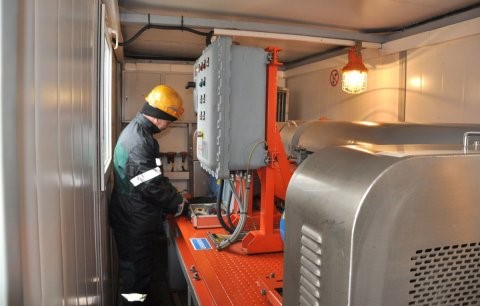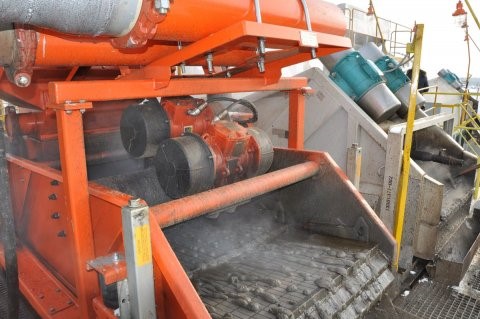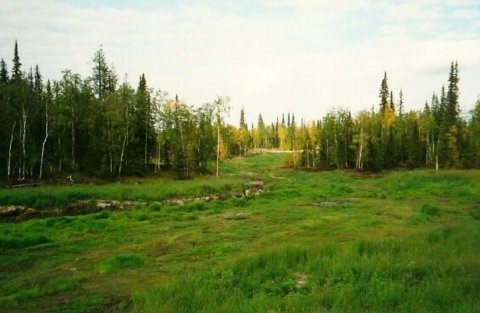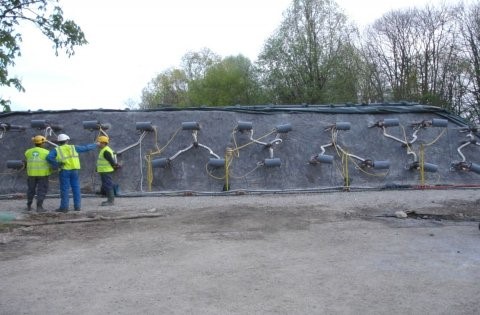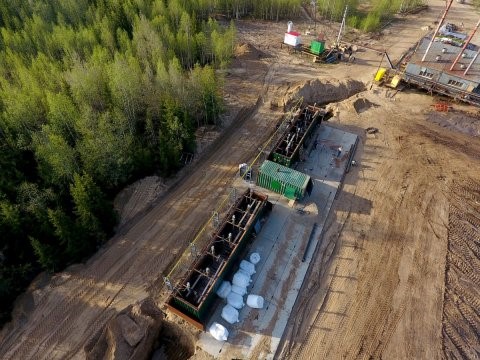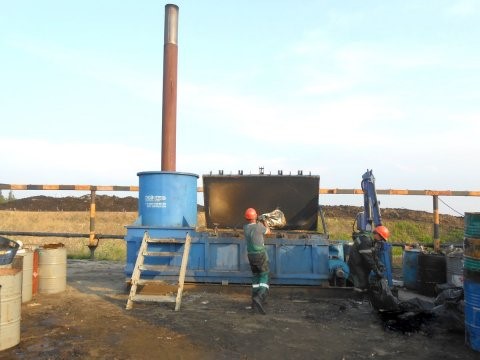
At present, our partner uses the following technologies for working with oil waste:
The technology has been implemented on the KUPNSH liquid oil sludge processing line. The unit capacity for liquid oil sludge is up to 100 m3 / day or up to 3000 m3 / month.
Parameters of liquid oil sludge (contaminated oil) entering the unit:
- oil content – 40-80%;
- water content – up to 60%
- the content of mechanical impurities – up to 20%.
Getting into the unit, liquid oil sludge (contaminated oil) is heated and goes through several stages of cleaning:
- 1.on a vibrating sieve (mechanical impurities larger than 0.25 mm are separated);
- on a hydrocyclone (mechanical impurities from 0.1 to 0.25 mm in size are separated);
- in a centrifuge (decanter or tricanter) with the addition of demulsifiers and flocculants, water and mechanical impurities are separated;
Parameters of the refined oil obtained at the unit:
- residual content of mechanical impurities – no more than 0.1% of the volume;
- the water content in the refined oil is 2% by volume;
Specific quality indicators are set in the relevant Regulations approved by the Customer.

Today there is an effective patented domestic technology for the disposal of oil sludge – low-temperature continuous pyrolysis based on thermal destruction units UTD-2 manufactured by IPEC (PG “Safe Technologies”).
The technology is implemented on the technological line for washing (cleaning) oil-contaminated soils and soils KUPNSH. In 2015, following the recommendations of the Belgian company DEC DEME, the line for flushing (cleaning) oil-contaminated soils and KUPNSH soils was modernized.
As a result, the technology has undergone some changes and currently oil-contaminated soils, soils and solid oil sludge pass through the following stages of preliminary separation and washing:
- On a roar (debris, wood residues, stones larger than 50 mm are separated);
- At the homogenization and scrubbing unit (a cleaning solution with a temperature of 600 C is added to oil-contaminated soils and soils, they are mixed into a homogeneous mass and in the process of friction of particles, oil is separated from the mineral fraction);
- On the hydroclassification block (the homogenized mass before the hydroclassifier is fed to a screen with a sieving surface of a mesh of 20 mm, where a fraction of more than 20 mm is separated. On the screen, a fraction of more than 20 mm is additionally washed, dehydrated and stored in a discharge box. Separated oil-contaminated soils and grounds are supplied to a hydroclassifier, where the mineral fraction of contaminated soils and soils is separated, which is a sand and gravel mixture, which falls down into the auger conveyor, from the organic fraction, which is vegetation and small wood residues, which is washed out in a laminar flow into a trough, which is fed to a vibrating sieve, and dehydrated.Further, dehydrated organic vegetation and small wood residues go to the incineration furnace for disposal);
- On the washing block (from the hydroclassifier, the mineral fraction of contaminated soils and soils is fed by a screw conveyor to the screen of the washing block with a sieving surface of 2 mm mesh, where a fraction of more than 2 mm is separated. The fraction less than 2 mm enters the buffer tank of the first stage filled with a cleaning solution at a temperature of 600 C, where the mineral fraction of oil-contaminated soils and soils passes another stage of washing, then the mineral fraction is fed through a sand separator (hydrocyclone) to the buffer tank of the second by a centrifugal slurry pump stages, also filled with a cleaning solution with a temperature of 600 C, and passes through the final stage of washing, and then is fed to the SGU with a centrifugal slurry pump,where it dehydrates and enters the unloading box of washed soil);
In addition, the KUPNSH unit is equipped with a waste cleaning solution purification unit, which receives the spent cleaning solution, which is a finely dispersed clay solution containing fine particles of sand and clay with a total content of no more than 2% of the total volume. Here the solution is purified (regenerated) in a centrifuge and enters the collection unit for the purified solution for reuse.
As a result of the modernization, the capacity of the plant in terms of feedstock increased to 60 m3 / day or up to 1800 m3 / month. With the addition of additional homogenization and scrubbing units, the capacity of the unit for washing oil-contaminated soils and soils can be increased to 130 or 200 m3 / day.
Bioremediation (cure) – a synonym for bioremediation – means the cleaning of soils from oil, oil products and other xenobiotics using either preparations of microorganisms that destroy specific contaminants, or the activation of indigenous microflora. Bioremediation also provides for the introduction of biogenic additives, for example, fertilizers, sediments from city treatment facilities, which also contain a variety of microorganisms, the introduction of plant growth stimulants, humates, special non-microbial preparations containing emulsifiers, microbial enzymes, bio-surfactants, amino acids, vitamins, sugars, lipids (fats), which are necessary for microorganisms to function.
Bioremediation, in turn, is subdivided into:
- Bioaugmentation (bioaugmentation) – the use of microorganisms-destructors of xenobiotics;
- Biostimulation (biostimulation) – stimulation of the vital activity of the aboriginal microflora of contaminated soil or soil.
Our partner applies bioremediation technology to the following materials:
- Oil-contaminated soils and soils taken from oil spill areas with a residual hydrocarbon content of 30 to 50 g / kg (where there is no possibility of on-site reclamation).
- Oil-contaminated soils and soils washed at the KUPNSH unit with a residual hydrocarbon content of 30 to 50 g / kg.
The purpose of bioremediation is to reduce the residual content of hydrocarbons in soils and grounds – below 30 g / kg, which corresponds to the regional standard for the acceptance of disturbed lands after restoration work.
Bioremediation of oil-contaminated soils and grounds is carried out according to the type of Bioaugmentation and Biostimulation with the addition of precipitation from city sewage treatment plants, which introduce new microflora and at the same time stimulate the aboriginal microflora. In the process of bioremediation, biogenic additives are used to stimulate the indigenous microflora, for example, fertilizers, as well as microbial enzymes, bio-surfactants, amino acids, vitamins, sugars, lipids (fats), which are necessary for microorganisms to function. Twice a week, aeration of soils and grounds is carried out by disking; in a dry period, moistening is carried out up to 20-40%.
The bioremediation technology was implemented during the biological reclamation of site No. 5 of the 1994 spill.
The technology was developed with the participation of Moscow State University.
For the recultivation of oil-contaminated lands on site No. 5, sediments from the city sewage treatment plants in Usinsk were used.
In 2017, it is planned to apply bioremediation technology at specially prepared sites at the Vozeiskoye and Usinskoye fields.
At present, the bioremediation technology used by our partner has passed the state ecological expertise at the Department of Rosprirodnadzor in the Komi Republic.
In order for microbes to purify harmful chemicals, the soil and groundwater must have the correct temperature, nutrients (fertilizers) and the required amount of oxygen. These conditions allow microorganisms to grow and multiply and consume more chemicals. To create the necessary conditions for the implementation of the bioremediation process, it is necessary to periodically plow to aerate the soil, add nutrients, and moisten.
Bioremediation is very safe because this method relies on microbes that naturally occur in the soil. These microbes are beneficial and pose no threat to people living in the area. Germs by themselves will not harm you, but never touch contaminated soil or groundwater, especially before eating.
No hazardous chemicals are used in bioremediation. The nutrients added for microbial growth are fertilizers commonly used on lawns and gardens. Since bioremediation converts harmful chemicals into water and harmless gases, harmful chemicals are completely destroyed.
The time it takes for bioremediation on a site or prepared site depends on several factors:
- the type and amount of harmful chemicals present,
- the size and depth of the contaminated zone,
- soil type and conditions,
- whether cleaning takes place above ground or underground.
These factors vary from site to site. It can take a few months to several years for microbes to consume the required amount of harmful chemicals to clean up the area.
Advantages of bioremediation technology:
- The safety of the method, since it is based on microbes that are naturally found in the soil;
- No hazardous chemicals are used in bioremediation. Harmless fertilizers and other nutrients serve as a nutrient medium for microorganisms;
- In the process of bioremediation, residual oil and oil products are converted into harmless water and carbon dioxide, without forming secondary waste;
- Bioremediation does not require a large amount of equipment and is a less expensive technology.
In August 2017, our partner, together with GEO Environmental Remediation Co (USA), will conduct pilot tests of low-temperature thermal desorption technology on a container-type installation in order to purify soils, soils contaminated with petroleum hydrocarbons and cake centrifugal plants at the Vozeisk field.
The principle of operation of the technology of low-temperature thermal desorption on a container-type installation:
Specially prepared containers (one unit is equipped with two containers) are loaded with oil-contaminated soils and grounds, cake of centrifugal units. In the upper part, the container is covered with a special heat-insulating material.
Pipes with burners are installed above the container in a vertical position, where gas is supplied.
The pipes heat the soil to the boiling points of hydrocarbon fractions, which leads to their evaporation and the extraction of volatile and semi-volatile pollutants (hydrocarbons).
Volatile contaminants are removed from the soil through vacuum extraction wells to condense and accumulate for further reuse, and non-volatile oil compounds settle and collect in a drainage tank. After purification, the starting material has a residual hydrocarbon content of up to 1000 mg / kg.
Advantages of low-temperature thermal desorption technology:
- Does not pollute the environment, there are no emissions in comparison with the technology of incineration. Minimum emissions only from natural gas combustion;
- Return of the pollutant (oil) for reuse;
- Fast, reliable, predictable cleaning of soil, sludge;
- Recovery of non-aqueous liquid phase of hydrocarbons for processing;
- Choice of fuel for heating: natural gas, propane, diesel fuel, ethanol;
- Flexible designs allow for batch processing from large (> 100,000 tons) to small (> 1000 tons) volumes of soil and sludge in some cases;
- Stationary or semi-stationary plants allow the reuse of multiple batch cleaning equipment;
- Soil moisture will affect cleaning time at temperatures> 100 ° C.
Benefits of using separate heaters:
- Low energy consumption
– 110-200 kWh per ton of soil cleaned
– Energy efficiency:> 65% - Safety
– Fully enclosed design
– Low power (40 kW) - Easy to Move (30 – 45 lbs)
– Modular Grid & Heated Site - Maximum control and flexibility
– Length, quantity, direction, timing, temperature
– Each burner is independent of the other and controlled by a PLC (programmable logic controller) - Reliability
– Easy replacement on site = no downtime
Advantages of low-temperature thermal desorption technology in a container-type plant:
- Full-scale batch application;
- Possibility of pilot testing at the facility;
- Suitable for temporary, small processing;
- It is used on remote objects, sensitive areas. The technology is applicable to soils, sludge, sediments;
- One unit is capable of purifying up to 450 cubic meters of feed material per month;
- Duration of cleaning from 9 to 21 days.
Subsequently, OOO SPASF “Priroda” plans to apply the technology of low-temperature thermal desorption in piles.
The principle of operation of the technology of low-temperature thermal desorption in piles:
Wells (pipes) with burners and wells for treating the soil with steam extraction are arranged in the soil dump, approximately 2-3 meters from each other;
Wells (pipes) with burners heat the soil, which leads to the destruction of non-volatile components of pollutants, and / or evaporation and extraction of water, volatile and semi-volatile pollutants;
Volatile contaminants are removed from the dump through vacuum extraction wells for further cleaning.
In the process of performing work on flushing oil-contaminated soils, grounds and solid oil sludge at oil sludge processing plants, a huge amount of oil-contaminated wood and organic residues, household and industrial waste is generated that require neutralization.
For the neutralization of oily waste separated during the washing of oil-contaminated soils, soils and solid oil sludge at plants, SPASF Priroda LLC uses Brener-1000 incinerators at the Usinskoye field and a combustion furnace reconstructed from the PKN-2G boiler (E-1 , 0-0.9G) at the Vozeiskoye field.
In addition to the separated waste, the incineration plants neutralize the oil-contaminated rags generated in the process of work by SPASF “Priroda” LLC and customer companies, special. clothing, waste oil and air filters and other oily waste.
Oil-contaminated waste generated during OSR operations (liquidation of the consequences of accidental oil and oil products spills) is rendered harmless at the Forsage-1 mobile incinerator.


